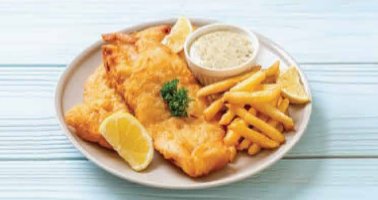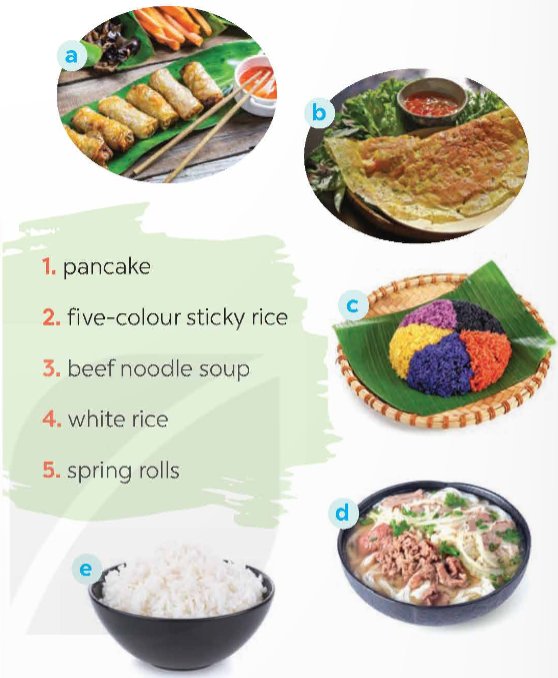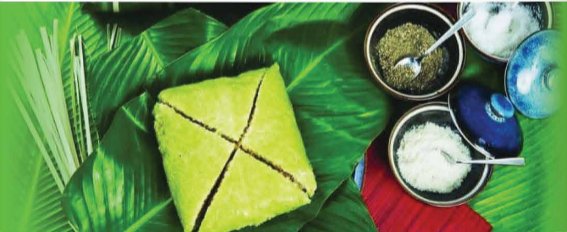Work in groups. Discuss the following question.
What do you know about England?
Work in groups. Discuss the following question.
What do you know about England?
Read the text and write the underlined words in the box.
England's traditions have been around for hundreds, even thousands of years. English cuisine is among the deep-rooted traditions that English people are proud to keep alive.
Typical English cuisine has developed over many centuries, and people say that fish and chips is the most English dish of all. It is believed that fish and chips appeared in England in the 19th century. The earliest fish and chip shop opened in London during the 1860s. Since then people have considered fish and chips to be England's national dish, and it is now a common takeaway in the United Kingdom
The basic ingredients of the dish are fried fish served with chips. People in different places may add peas, vinegar, lemon, or ketchup. Fish and chips is served hot as the main dish in England. Although there is oil and carbohydrates in fish and chips, it is healthier than other takeaway dishes.
Now there are fish and chip shops in many countries, and it is becoming more and more popular in other countries too. Preserving and promoting fish and chips is the way English people keep themselves associated with the past.

Meaning/Explanation | Word |
1. linked or connected 2. difficult to change or destroy 3. started to be seen 4. necessary and important |
|
Thảo luận (1)Hướng dẫn giải(Trả lời bởi Nguyễn Quốc Đạt)
Meaning/Explanation
(Ý nghĩa/Giải thích)
Word
(Từ)
1. linked or connected
(liên kết hoặc kết nối)
associated
(liên kết)
2. difficult to change or destroy
(khó thay đổi hay tiêu diệt)
deep-rooted
(ăn sâu, tận gốc rễ)
3. started to be seen
(bắt đầu được nhìn thấy)
appeared
(xuất hiện)
4. necessary and important
(cần thiết và quan trọng)
basic
(cơ bản)
Read the text again and tick (✔) T (True) or F (False) for each sentence.
| T | F |
1. English people take great pride in their traditions. |
|
|
2. Fish and chips has been around for hundreds of years. |
|
|
3. The earliest fish and chip shop opened in London in 1860. |
|
|
4. Peas, vinegar, lemon, or ketchup are necessary for fish and chips. |
|
|
5. Fish and chips is not healthy as it has a lot of oil. |
|
|
6. Fish and chips is sold in many countries now. |
|
|
Thảo luận (1)Hướng dẫn giải
1. T
2. T
3. F
4. F
5. F
6. T
1. T
English people take great pride in their traditions.
(Người Anh rất tự hào về truyền thống của họ.)
Thông tin: English cuisine is among the deep-rooted traditions that English people are proud to keep alive.
(Ẩm thực Anh là một trong những truyền thống lâu đời mà người Anh tự hào được gìn giữ.)
2. T
Fish and chips has been around for hundreds of years.
(Cá và khoai tây chiên đã có từ hàng trăm năm nay.)
Thông tin: It is believed that fish and chips appeared in England in the 19th century.
(Người ta tin rằng cá và khoai tây chiên xuất hiện ở Anh vào thế kỷ 19.)
3. F
The earliest fish and chip shop opened in London in 1860.
(Cửa hàng bán cá và khoai tây chiên sớm nhất được mở ở London vào năm 1860.)
Thông tin: The earliest fish and chip shop opened in London during the 1860s.
(Cửa hàng bán cá và khoai tây chiên sớm nhất được mở ở London vào những năm 1860.)
4. F
Peas, vinegar, lemon, or ketchup are necessary for fish and chips.
(Đậu Hà Lan, giấm, chanh hoặc sốt cà chua là cần thiết cho món cá và khoai tây chiên.)
Thông tin: The basic ingredients of the dish are fried fish served with chips. People in different places may add peas, vinegar, lemon, or ketchup.
(Nguyên liệu cơ bản của món ăn là cá chiên ăn kèm khoai tây chiên. Mọi người ở những nơi khác nhau có thể thêm đậu Hà Lan, giấm, chanh hoặc sốt cà chua.)
5. F
Fish and chips is not healthy as it has a lot of oil.
(Cá và khoai tây chiên không tốt cho sức khỏe vì có nhiều dầu.)
Thông tin: Although there is oil and carbohydrates in fish and chips, it is healthier than other takeaway dishes.
(Mặc dù có dầu và carbohydrate trong cá và khoai tây chiên nhưng nó tốt cho sức khỏe hơn các món ăn mang đi khác.)
6. T
Fish and chips is sold in many countries now.
(Hiện nay cá và khoai tây chiên được bán ở nhiều nước.)
Thông tin: Now there are fish and chip shops in many countries, and it is becoming more and more popular in other countries too.
(Hiện nay có các cửa hàng bán cá và khoai tây chiên ở nhiều quốc gia và nó ngày càng trở nên phổ biến ở các quốc gia khác.)
(Trả lời bởi Nguyễn Quốc Đạt)
Work in pairs. Match 1-5 in column A with a - e in column B.
A | B |
1. name of the dish | a. glutinous rice, green beans, pork |
2. history | b. at Tet, on the Hung Kings' anniversary |
3. basic ingredients | c. banh chung |
4. on what occasion it's eaten | d. traditional dish |
5. type of dish | e. originated in 6th Hung King's time |
Thảo luận (1)Hướng dẫn giải1 – c. name of the dish: banh chung
(tên món ăn: bánh chưng)
2 – e. history: originated in 6th Hung King's time
(lịch sử: bắt nguồn từ thời Hùng Vương thứ 6)
3 – a. basic ingredients: glutinous rice, green beans, pork
(nguyên liệu cơ bản: gạo nếp, đậu xanh, thịt lợn)
4 – b. on what occasion it's eaten: at Tet, on the Hung Kings' anniversary
(ăn vào dịp nào: Tết, giỗ tổ Hùng Vương)
5 – d. type of dish: traditional dish
(loại món ăn: món ăn truyền thống)
(Trả lời bởi Nguyễn Quốc Đạt)
Work in groups. Match the Vietnamese dishes with their names in English.

Choose a typical traditional Vietnamese dish and talk about it.
Your talk should include:
- the name of the dish
- the basic ingredients
- when/ on what occasion it is eaten
- whether you like it or not

Thảo luận (1)Hướng dẫn giải1 - b. pancake (bánh xèo)
2 - c. five-colour sticky rice (xôi ngũ sắc)
3 - d. beef noodle soup (phở bò)
4 - e. white rice (cơm trắng)
5 - a. spring rolls (nem cuốn)
- the name of the dish: five-colour sticky rice
(tên món ăn: xôi ngũ sắc)
- the basic ingredients: sticky rice, natural coloring ingredients (pandan leaves, gac fruit, turmeric, and butterfly pea flower/black rice leaves)
(các nguyên liệu cơ bản: gạo nếp, thành phần tạo màu tự nhiên (lá dứa, quả gấc, nghệ, hoa đậu biếc/lá cẩm))
- when/ on what occasion it is eaten: on important occasions such as Mid-Autumn Festival, full moon days, Tet holidays, weddings and death anniversaries
(nó được ăn khi nào/vào dịp nào: vào những dịp quan trọng như Trung thu, rằm, lễ Tết, đám cưới, giỗ)
- whether you like it or not: I like it for its unique presentation and diverse flavors
(bạn có thích nó hay không: tôi thích nó vì cách trình bày độc đáo và hương vị đa dạng)
Five-colour sticky rice, known as "xôi ngũ sắc" in Vietnamese, is a traditional dish of Vietnam. People call the dish five-coloured sticky rice because it has five colours: red, yellow, green, purple and white. The five colours of the dish represent five elements of life according to Vietnamese beliefs: yellow is earth, red is fire, green is plants, white is metal, and purple or black is water. The basic ingredients include sticky rice, natural colorants (pandan leaves, gac fruit, turmeric, and butterfly pea flower/black rice leaves) and toppings (mung beans, shredded coconut, sesame seeds). It is usually eaten on important occasions such as Mid-Autumn Festival, full moon days, Tet holidays, weddings and death anniversaries, or whenever the family has guests. This dish symbolizes joy and prosperity.I like it for its unique presentation and diverse flavors.
Tạm dịch:
Xôi ngũ sắc là một món ăn truyền thống của Việt Nam. Người ta gọi món xôi ngũ sắc vì nó có 5 màu: đỏ, vàng, xanh lá cây, tím và trắng. Năm màu của món ăn tượng trưng cho năm yếu tố của cuộc sống theo tín ngưỡng của người Việt: vàng là đất, đỏ là lửa, xanh là thực vật, trắng là kim loại và tím hoặc đen là nước. Nguyên liệu cơ bản bao gồm gạo nếp và chất tạo màu tự nhiên (lá dứa, quả gấc, nghệ và hoa đậu biếc/lá gạo đen) và các topping (đậu xanh, dừa vụn, hạt vừng). Món ăn này thường được ăn vào những dịp quan trọng như Trung thu, rằm, lễ Tết, đám cưới, giỗ hay bất cứ khi nào gia đình có khách. Món ăn này tượng trưng cho niềm vui và sự thịnh vượng. Tôi thích nó vì cách trình bày độc đáo và hương vị đa dạng.
(Trả lời bởi Nguyễn Quốc Đạt)